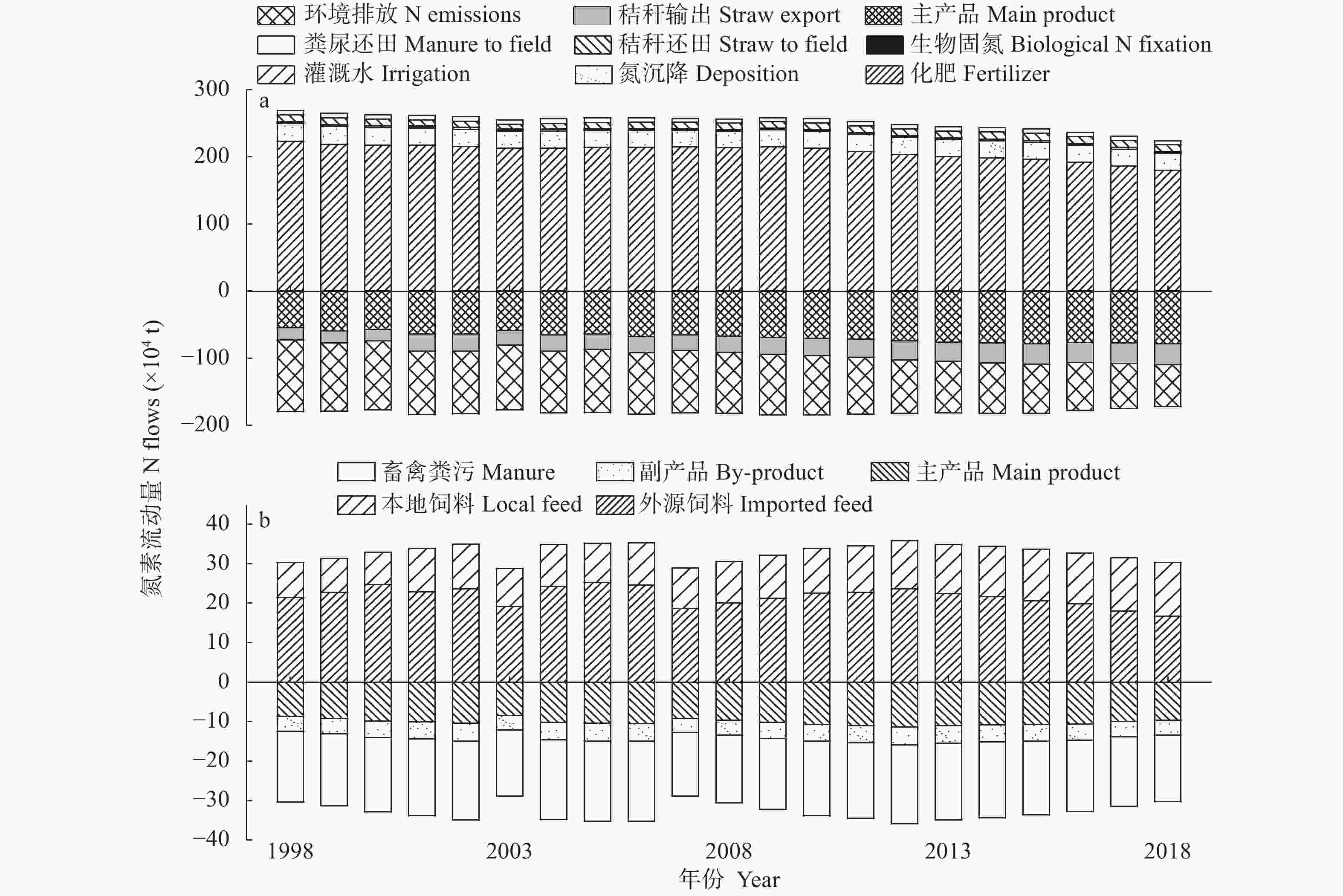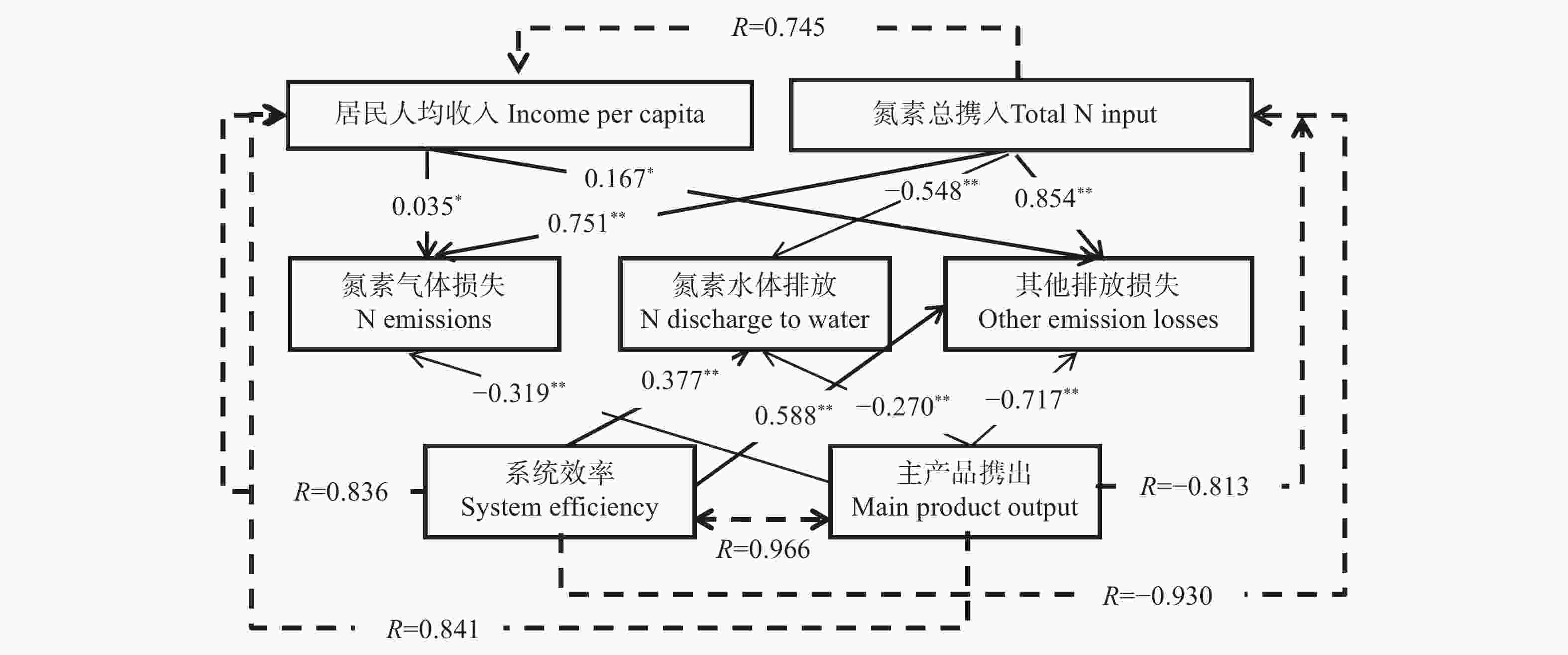Characteristics and environmental effects of nitrogen flows in the crop-livestock system of Jiangsu Province
-
摘要: 针对农牧业快速发展过程中氮素大量投入引起的一系列问题, 本文以江苏省为研究对象, 探讨1998—2018年农牧系统氮素流动特征及其环境效应, 以期为区域氮素资源管理提供科学参考。研究基于食物链养分流动模型(NUtrient flows in Food chains, Environment and Resources use, NUFER), 结合统计年鉴数据、调研数据和文献数据, 定量分析江苏省农牧系统氮素账户平衡、各系统氮素利用效率、氮素循环利用和损失情况, 并基于结构方程模型探讨农牧系统中经济-资源-环境间的关系。1998—2018年, 江苏省作物子系统在系统氮素总输入逐步减少的情况下实现了产品携出氮素的较大增长, 作物主副产品氮素携出量由8.31×105 t增至1.20×106 t, 氮素损失总量也在不断降低。对于畜禽子系统, 氮素输入主要包括外源饲料和本地饲料输入, 其中外源饲料是子系统的主要氮素来源; 且本地饲料氮素供给比例在逐年上升, 从1998年的29.32%增长至2018年的44.77%。1998—2018年, 农牧系统氮素利用率由21.39%增至35.00%, 呈上升趋势, 本地饲料、秸秆还田和粪尿还田氮素量逐年上升, 氮素资源循环利用总量由2.54×105 t增至3.00×105 t。从氮素排放损失来看, 20多年来环境排放部分呈下降趋势, 其主要损失途径包括土壤氮素盈余、气体排放损失、水体排放损失和粪污残余损失。结构方程模型核算结果表明江苏省农牧系统的发展过程中, 经济发展和资源减量推动了产品产量和系统效率的提高。总的来说, 受区域发展水平和政策引导, 1998—2018年江苏省农牧体系发展较快, 规模不断扩大, 资源利用相对高效, 环境排放逐渐减少; 但农牧子系统之间的发展不平衡, 农牧结合体系规模相对较小等问题仍值得关注。因此, 今后江苏省农牧业的发展应注重作物子系统和畜牧子系统的耦合, 适度扩大生产规模, 以促进本地农牧业更好发展。Abstract: With the rapid development of agriculture and animal husbandry, large nitrogen inputs have caused a series of environmental problems. To provide a scientific reference for regional nutrient management, Jiangsu Province, an economically developed region in the Yangtze River Delta, was selected to study the nitrogen flow characteristics in crop-livestock systems from 1998 to 2018 and their environmental effects. The research was based on the NUFER model (NUtrient flows in Food chains, Environment and Resources use, NUFER) and incorporated statistical yearbook data, survey data, and literature data. The nitrogen account balance, nitrogen use efficiency, nitrogen recycling, and loss of the crop-livestock systems in Jiangsu Province were quantitatively analyzed, and the relationships between the economy, resources, and environment of the crop-livestock systems were explored based on a structural equation model. The results showed that from 1998 to 2018, the crop subsystem increased the amount of nitrogen carried by the crop products under the gradual decrease of the total nitrogen imports of the subsystem. Nitrogen carried by the main crops and crop by-products increased from 8.31×105 t to 1.20×106 t. Total nutrient loss also declined. For the livestock-poultry subsystem, nitrogen was mainly introduced via exogenous and local feed; exogenous feed was the main source of nitrogen in the subsystem. The proportion of local feed nitrogen supply increased annually, from 29.32% in 1998 to 44.77% in 2018. From 1998 to 2018, the nitrogen use efficiency of the crop-livestock system increased from 21.39% to 35.00%. The amount of straw to field, local feed, and manure to field increased annually, and the total amount of recycled nitrogen increased from 2.54×105 t to 3.00×105 t. Nitrogen environmental emissions decreased in the past 20 years, and the main sources of loss included soil nitrogen surplus, gas emission loss, water discharge loss, and manure residue. The structural equation model results showed that in the developmental process of the agricultural and animal husbandry systems in Jiangsu Province, economic development and resource reduction promoted improvements in product output and system efficiency. Under the guidance of regional development and policies, crop-livestock systems in Jiangsu Province developed rapidly from 1998 to 2018. The scale of the agricultural and animal husbandry systems had continuously expanded, resource utilization had been relatively efficient, and environmental emissions had gradually decreased. However, there was also a slight imbalance in the development of crop-livestock systems, and there were relatively few combinations of crop-livestock. Future development of the agriculture and animal husbandry systems in Jiangsu Province should focus on coupling the crop and animal husbandry subsystems, moderately expanding the production scale, and balancing the development of agriculture and animal husbandry subsystems to promote local agriculture and animal husbandry.
-
Key words:
- Jiangsu Province /
- Crop-livestock system /
- Nitrogen flows /
- NUFER model /
- Environmental effects
-
图 2 1998—2018年江苏省作物子系统(a)和畜禽子系统(b)的氮素流动变化
图中横坐标以上部分为氮素输入各项, 横坐标以下部分为氮素输出各项。In the figure, the above part of the abscissa is N input items, and the below part of the abscissa is N output items.
Figure 2. N flows changes in the crop subsystem (a) and livestock subsystem (b) from 1998 to 2018 in Jiangsu Province
图 3 1998—2018年江苏省农牧系统氮素利用效率(a)、氮素循环利用率(b)和氮素损失情况(c)
NUEc: N use efficiency of crop subsystem; NUEa: N use efficiency of livestock subsystem; NUEa+c: N use efficiency of crop-livestock system.
Figure 3. N use efficiency (a), N cycle utlization rate (b) and N loss (c) in the crop-livestock system of Jiangsu Province from 1998 to 2018
图 4 江苏省农牧体系结构方程模型建模结果示意图
图中实线部分表示社会需求(居民人均收入和氮素总携入)、系统发展(系统效率和主产品携出)与环境效应(气体损失、水体排放和其他途径损失)间的关系, 粗实线表示具有正效应, 细实线表示具有负效应; 虚线部分为社会需求和系统发展间的关系; 数值部分为标准化路径系数; **表示P<0.01, *表示P<0.05, R为相关系数值。The solid line shows the relationship between social demand (income per capita and total nitrogen input), system development (system efficiency and main product output) and environmental effect (gas loss, water discharge and other route loss). The thick solid line shows positive effect and the thin solid line shows negative effect. The dotted line shows the relationship between social demand and system development. The numerical part is the standardized path coefficient. ** means P<0.01, * means P<0.05, and R is the correlation value.
Figure 4. Schematic diagram of structural equation modeling results of the crop-livestock system in Jiangsu Province
表 1 作物子系统中氮素损失去向和损失比例
Table 1. The direction and proportion of N loss in the crop subsystem
项目 Item 参数 Parameter 项目 Item 参数 Parameter 输入项 Imports 生物固氮[24] Biological N fixation[24] 19 kg(N)∙hm−2 输出项 Outputs NH3[33] 15.0% N2O[33] 1.0% 大气氮沉降[24] N deposition[24] 33 kg(N)∙hm−2 反硝化[33] Denitrification[33] 15.0% 径流[10] Runoff[10] 15.8% 灌溉水氮携入[29] Irrigation[29] 5.2 kg(N)∙hm−2 侵蚀[10] Erossion[10] 0.7% 淋溶[10] Leaching[10] 18.8% 畜禽种类
Animal category鲜重
Fresh weight (kg)养殖周期
Days (d)分配系数 Distribution coefficient (%) 氮素含量 N content (%) 可食用比例
Ratio of edible part骨头比例
Ratio of bones其他
Ratio of by-products可食用部分
Edible part骨头部分
Bones其他
By-products猪 Pig 90 199 50 13 37 1.5 1.9 2.2 奶牛 Dairy cattle 624 >365 45 20 35 2.8 1.8 2.2 肉牛 Beef cattle 316 >365 45 20 35 2.8 1.8 2.2 役用牛 Draft cattle 328 >365 45 20 35 2.8 1.8 2.2 羊 Sheep 35 243 55 24 21 2.1 1.9 2.2 肉禽 Poultry 2 60 65 20 15 2.7 2.6 1.5 畜禽种类 Animal category 氮素产生量 N production (g·d−1) NH3 (%) N2O (%) 反硝化 Denitrification (%) 无序排放
Other emission猪 Pig 20.76 28 2.0 5.0 32.5 奶牛 Dairy cattle 214.51 21 4.0 5.0 24.5 肉牛 Beef cattle 153.47 21 4.0 5.0 24.5 役用牛 Draft cattle 107.77 21 4.0 5.0 24.5 羊 Sheep 2.15 25 1.0 5.0 53.1 肉禽 Poultry 1.02 22 1.0 5.0 39.6 -
[1] GODFRAY H C J, BEDDINGTON J R, CRUTE I R, et al. Food security: the challenge of feeding 9 billion people[J]. Science, 2010, 327(5967): 812−818 doi: 10.1126/science.1185383 [2] HERRERO M, THORNTON P K. Livestock and global change: emerging issues for sustainable food systems[J]. PNAS, 2013, 110(52): 20878−20881 doi: 10.1073/pnas.1321844111 [3] ZHANG F S, CHEN X P, VITOUSEK P. Chinese agriculture: an experiment for the world[J]. Nature, 2013, 497(7447): 33−35 doi: 10.1038/497033a [4] JIN X, BAI Z H, OENEMA O, et al. Spatial planning needed to drastically reduce nitrogen and phosphorus surpluses in China’s agriculture[J]. Environmental Science & Technology, 2020, 54(19): 11894−11904 [5] CHEN X, STROKAL M, KROEZE C, et al. Modeling the contribution of crops to nitrogen pollution in the Yangtze River[J]. Environmental Science & Technology, 2020, 54(19): 11929−11939 [6] DUMONT E, HARRISON J A, KROEZE C, et al. Global distribution and sources of dissolved inorganic nitrogen export to the coastal zone: Results from a spatially explicit, global model[J]. Global Biogeochemical Cycles, 2005, 19(4): GB4S02 [7] SEITZINGER S P, MAYORGA E, BOUWMAN A F, et al. Global river nutrient export: a scenario analysis of past and future trends[J]. Global Biogeochemical Cycles, 2010, 24(4): 2621−2628 [8] STROKAL M, YANG H, ZHANG Y C, et al. Increasing eutrophication in the coastal seas of China from 1970 to 2050[J]. Marine Pollution Bulletin, 2014, 85(1): 123−140 doi: 10.1016/j.marpolbul.2014.06.011 [9] WOLF J, BEUSEN A H W, GROENENDIJK P, et al. The integrated modeling system STONE for calculating nutrient emissions from agriculture in the Netherlands[J]. Environmental Modelling & Software, 2003, 18(7): 597−617 [10] VELTHOF G L, OUDENDAG D, WITZKE H P, et al. Integrated assessment of nitrogen losses from agriculture in EU-27 using MITERRA-EUROPE[J]. Journal of Environmental Quality, 2009, 38(2): 402−417 doi: 10.2134/jeq2008.0108 [11] MISHIMA S I, KIMURA S D, EGUCHI S, et al. Estimation of the amounts of livestock manure, rice straw, and rice straw compost applied to crops in Japan: a bottom-up analysis based on national survey data and comparison with the results from a top-down approach[J]. Soil Science and Plant Nutrition, 2012, 58(1): 83−90 doi: 10.1080/00380768.2012.658581 [12] ARTHUR R, BAIDOO M F. Harnessing methane generated from livestock manure in Ghana, Nigeria, Mali and Burkina Faso[J]. Biomass and Bioenergy, 2011, 35(11): 4648−4656 doi: 10.1016/j.biombioe.2011.09.009 [13] MA L, MA W Q, VELTHOF G L, et al. Modeling nutrient flows in the food chain of China[J]. Journal of Environmental Quality, 2010, 39(4): 1279−1289 doi: 10.2134/jeq2009.0403 [14] MA L, ZHANG W F, MA W Q, et al. An analysis of developments and challenges in nutrient management in China[J]. Journal of Environmental Quality, 2013, 42(4): 951−961 doi: 10.2134/jeq2012.0459 [15] BAI Z H, LI X X, LU J, et al. Livestock housing and manure storage need to be improved in China[J]. Environmental Science & Technology, 2017, 51(15): 8212−8214 [16] HOU Y, MA L, GAO Z L, et al. The driving forces for nitrogen and phosphorus flows in the food chain of China, 1980 to 2010[J]. Journal of Environmental Quality, 2013, 42(4): 962−971 doi: 10.2134/jeq2012.0489 [17] WEI S, BAI Z H, QIN W, et al. Environmental, economic and social analysis of peri-urban pig production[J]. Journal of Cleaner Production, 2016, 129: 596−607 doi: 10.1016/j.jclepro.2016.03.133 [18] ZHANG J J, GUO C X, ZHANG Y G, et al. Spatial characteristics of nitrogen flows in the crop and livestock production system of Shanxi Province, China[J]. Acta Ecologica Sinica, 2016, 36(2): 99−107 doi: 10.1016/j.chnaes.2016.01.007 [19] 丁尚, 郭浩浩, 程鸣宇, 等. 海南农牧生产体系氮素养分流动时空变化特征[J]. 中国生态农业学报(中英文), 2019, 27(2): 246−256DING S, GUO H H, CHENG M Y, et al. Spatial and temporal characteristics of nitrogen flows in farming and animal production system in Hainan Province[J]. Chinese Journal of Eco-Agriculture, 2019, 27(2): 246−256 [20] 张晓萌, 王寅, 焉莉, 等. 东北地区农牧系统氮、磷养分流动特征[J]. 中国农业科学, 2018, 51(3): 417−429 doi: 10.3864/j.issn.0578-1752.2018.03.003ZHANG X M, WANG Y, YAN L, et al. Characteristics of nitrogen and phosphorus nutrient flow in farming and animal husbandry system in northeast China[J]. Scientia Agricultura Sinica, 2018, 51(3): 417−429 doi: 10.3864/j.issn.0578-1752.2018.03.003 [21] 佟丙辛, 张华芳, 高肖贤, 等. 华北平原典型区域农牧系统氮素流动及其环境效应−以河北省为例[J]. 中国农业科学, 2018, 51(3): 442−455 doi: 10.3864/j.issn.0578-1752.2018.03.005TONG B X, ZHANG H F, GAO X X, et al. Nitrogen flow and environmental effects of crop-livestock system in typical area of North China Plain-A case study in Hebei Province[J]. Scientia Agricultura Sinica, 2018, 51(3): 442−455 doi: 10.3864/j.issn.0578-1752.2018.03.005 [22] 江苏省统计局. 江苏统计年鉴(1999—2019)[M]. 北京: 中国统计出版社, 1999—2019Jiangsu Statistical Bureau. Jiangsu Statistical Yearbook (1999—2019) [M]. Beijing: China Statistics Press, 1999−2019 [23] 国家统计局. 中国统计年鉴(1999—2019)[M]. 北京: 中国统计出版社, 1999—2019State Statistics Bureau. Chinese Statistical Yearbook (1999—2019) [M]. Beijing: China Statistics Press, 1999—2019 [24] MA L, VELTHOF G L, WANG F H, et al. Nitrogen and phosphorus use efficiencies and losses in the food chain in China at regional scales in 1980 and 2005[J]. Science of the Total Environment, 2012, 434: 51−61 doi: 10.1016/j.scitotenv.2012.03.028 [25] BOUWMAN A F, BOUMANS L J M, BATJES N H. Modeling global annual N2O and NO emissions from fertilized fields[J]. Global Biogeochemical Cycles, 2002, 16(4): 28-1−28-9 [26] BOUWMAN A F, BOUMANS L J M, BATJES N H. Emissions of N2O and NO from fertilized fields: Summary of available measurement data[J]. Global Biogeochemical Cycles, 2002, 16(4): 6-1−6-13 [27] CAI G X, CHEN D L, DING H, et al. Nitrogen losses from fertilizers applied to maize, wheat and rice in the North China Plain[J]. Nutrient Cycling in Agroecosystems, 2002, 63(2/3): 187−195 doi: 10.1023/A:1021198724250 [28] 李书田, 金继运. 中国不同区域农田养分输入、输出与平衡[J]. 中国农业科学, 2011, 44(20): 4207−4229LI S T, JIN J Y. Characteristics of nutrient input/output and nutrient balance in different regions of China[J]. Scientia Agricultura Sinica, 2011, 44(20): 4207−4229 [29] 刘晓利. 我国“农田—畜牧—营养—环境”体系氮素养分循环与平衡[D]. 保定: 河北农业大学, 2005LIU X L. Nitrogen cycling and balance in “agriculture-livestock-nutrition-environment” system of China[D]. Baoding: Hebei Agricultural University, 2005 [30] 中国农业科学院农业环境与可持续发展研究所, 环境保护部南京环境科学研究所. 第一次全国污染源普查畜禽养殖业产排污系数与排污系数手册[R]. 2009Institute of Environment and Sustainable Development in Agriculture, Chinese Academy of Agricultural Sciences, Nanjing Institute of Environmental Sciences, Ministry of Environmental Protection of the People’s Republic of China. The First National Pollution Census: The Manuals of Sewage Capacity Factor of Livestock Breeding Industry Source[R]. 2009 [31] 张建杰, 郭彩霞, 覃伟, 等. 山西省畜禽业发展及粪尿养分时空变异[J]. 应用生态学报, 2016, 27(1): 207−214ZHANG J J, GUO C X, QIN W, et al. Temporal and spatial variability of livestock and poultry productions and manure nutrients in Shanxi Province, China[J]. Chinese Journal of Applied Ecology, 2016, 27(1): 207−214 [32] 耿维, 胡林, 崔建宇, 等. 中国区域畜禽粪便能源潜力及总量控制研究[J]. 农业工程学报, 2013, 29(1): 171−179, 295GENG W, HU L, CUI J Y, et al. Biogas energy potential for livestock manure and gross control of animal feeding in region level of China[J]. Transactions of the Chinese Society of Agricultural Engineering, 2013, 29(1): 171−179, 295 [33] HERRERO M, THORNTON P K, NOTENBAERT A M, et al. Smart investments in sustainable food production: revisiting mixed crop-livestock systems[J]. Science, 2010, 327(5967): 822−825 doi: 10.1126/science.1183725 [34] HU H W, WANG J T, LI J, et al. Long-term nickel contamination increases the occurrence of antibiotic resistance genes in agricultural soils[J]. Environmental Science & Technology, 2017, 51(2): 790−800 [35] 中华人民共和国农业农村部. 全国农业可持续发展规划(2015—2030年)[R]. 农计发[2015]145号. http://www.moa.gov.cn/ztzl/mywrfz/gzgh/201509/t20150914_4827900.htmMinistry of Agriculture and Rural Affairs of the People’s Republic of China. National Plan for Sustainable Agricultural Development (2015—2030)[R]. Njf 145 [2015]. http://www.moa.gov.cn/ztzl/mywrfz/gzgh/201509/t20150914_4827900.htm [36] 江苏省发展和改革委员会. 江苏省国民经济和社会发展第十三个五年规划纲要[R]. 2016. http://fzggw.jiangsu.gov.cn/art/2016/3/31/art_50999_7275522.htmlDevelopment and Reform Commission of Jiangsu Province. The Outline of the Thirteenth Five-Year Plan for National Economic and Social Development of Jiangsu Province[R]. 2016. http://fzggw.jiangsu.gov.cn/art/2016/3/31/art_50999_7275522.html [37] 陈敏鹏, 陈吉宁. 中国种养系统的氮流动及其环境影响[J]. 环境科学, 2007, 28(10): 2342−2349 doi: 10.3321/j.issn:0250-3301.2007.10.033CHEN M P, CHEN J N. Nitrogen flow in farming-feeding system and its environmental impact in China[J]. Environmental Science, 2007, 28(10): 2342−2349 doi: 10.3321/j.issn:0250-3301.2007.10.033 [38] 王激清, 马文奇, 江荣风, 等. 中国农田生态系统氮素平衡模型的建立及其应用[J]. 农业工程学报, 2007, 23(8): 210−215 doi: 10.3321/j.issn:1002-6819.2007.08.038WANG J Q, MA W Q, JIANG R F, et al. Development and application of nitrogen balance model of agro-ecosystem in China[J]. Transactions of the Chinese Society of Agricultural Engineering, 2007, 23(8): 210−215 doi: 10.3321/j.issn:1002-6819.2007.08.038 [39] 陈轩敬, 宫雅慧, 谢军, 等. 近20年重庆市农牧生产体系氮素流动特征及驱动力分析[J]. 中国农业科学, 2018, 51(3): 468−480 doi: 10.3864/j.issn.0578-1752.2018.03.007CHEN X J, GONG Y H, XIE J, et al. Nitrogen flow of crop-livestock production system and its driving forces in Chongqing over the past 20 years[J]. Scientia Agricultura Sinica, 2018, 51(3): 468−480 doi: 10.3864/j.issn.0578-1752.2018.03.007 [40] 张建杰, 郭彩霞, 李莲芬, 等. 农牧交错带农牧系统氮素流动与环境效应−以山西省为例[J]. 中国农业科学, 2018, 51(3): 456−467 doi: 10.3864/j.issn.0578-1752.2018.03.006ZHANG J J, GUO C X, LI L F, et al. Nutrient flow and environmental effects on crop-livestock system in farming-pastoral transition zone—A case study in Shanxi Province[J]. Scientia Agricultura Sinica, 2018, 51(3): 456−467 doi: 10.3864/j.issn.0578-1752.2018.03.006 [41] 魏莎, 柏兆海, 吴迪梅, 等. 都市圈“土壤-饲料-动物”系统养分流动与环境效应−以北京市为例[J]. 中国农业科学, 2018, 51(3): 430−441 doi: 10.3864/j.issn.0578-1752.2018.03.004WEI S, BAI Z H, WU D M, et al. Nutrient flow and environmental effects of “soil-feed-livestock” system in metropolis: a case study in Beijing[J]. Scientia Agricultura Sinica, 2018, 51(3): 430−441 doi: 10.3864/j.issn.0578-1752.2018.03.004 [42] 李晓琳, 郑毅. 云南省农牧生产系统氮素流动时空变化特征与环境效应[J]. 中国农业科学, 2018, 51(3): 481−492 doi: 10.3864/j.issn.0578-1752.2018.03.008LI X L, ZHENG Y. Spatial-temporal distribution of nitrogen nutrient flow and environmental effects of crop-livestock system in Yunnan Province[J]. Scientia Agricultura Sinica, 2018, 51(3): 481−492 doi: 10.3864/j.issn.0578-1752.2018.03.008 [43] OENEMA O, OUDENDAG D, VELTHOF G L. Nutrient losses from manure management in the European Union[J]. Livestock Science, 2007, 112(3): 261−272 doi: 10.1016/j.livsci.2007.09.007 [44] OENEMA O, KROS H, DE VRIES W. Approaches and uncertainties in nutrient budgets: implications for nutrient management and environmental policies[J]. European Journal of Agronomy, 2003, 20(1/2): 3−16 -






 下载:
下载:






